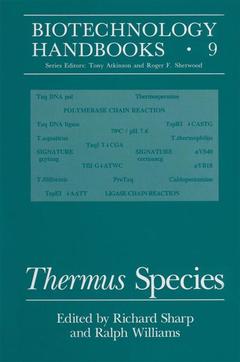Thermus Species, Softcover reprint of the original 1st ed. 1995 Biotechnology Handbooks Series, Vol. 9
Langue : Anglais
Coordonnateurs : Sharp Richard, Williams Ralph

There is considerable interest in thermophile microorganisms, in their environments, their ability to survive at temperatures which normally denature proteins, but more importantly, as a valuable resource for bio technology. The first reported isolation of Thermus by Tom Brock was in 1969. This initiated the present era of thermophilic research with the realization that where liquid water is available, there may be no limits to the temper ature at which microorganisms can grow. Considerable research into the ecology, physiology, metabolism, and thermostable enzymes of thermo philes has led to their evaluation for a range of industrial and commercial processes. The past fifteen years have been an explosive period of dis covery of many new genera and species, including the descriptions of a new fundamental kingdom-the Archaea. Much of the current research has been focused on the Archaea; but it is significant that during this period, the original type strain YT-l of Thermus aquaticus described by Brock has provided a major step forward in molecular biology. DNA polymerase from strain YT-I has proved to be the major success in the commercialization of enzymes from thermophilic microorganisms to date. The ease with which Thermus strains can be handled in laboratories without specialized equipment, together with the large investment in de scribing their structure, metabolism, and genetics, should ensure a con tinuing effort in Thermus research.
1 The Taxonomy and Identification of Thermus.- 1. Introduction and General Properties of Thermus.- 2. Cell Wall Structure.- 3. Pigments and Lipids.- 4. Phenotypic Properties.- 5. Nucleic Acid Studies.- 6. The Species of Thermus.- References.- 2 Ecology, Distribution, and Isolation of Thermus.- 1. Ecology and Distribution.- 2. Isolation of Thermus.- References.- 3 Physiology and Metabolism of Thermus.- 1. Enzymes of the Main Metabolic Pathways.- 2. Utilization of Substrates for Growth and Energy.- 3. Energetics.- 4. Microbial Growth.- References.- 4 Enzymes of Thermus and Their Properties.- 1. Introduction.- 2. Thermal Stability.- 3. Oxidoreductases.- 4. Transferases.- 5. Hydrolases.- 6. Lyases.- 7. Isomerases.- 8. Ligases.- 9. Miscellaneous.- References.- 5 The Cell Walls and Lipids of Thermus.- 1. Introduction.- 2. Cell Wall Structure and Composition.- 3. Lipid Composition.- 4. Temperature-Induced Alterations in Lipids.- 5. Final Considerations.- References.- 6 Genetics of Thermus: Plasmids, Bacteriophage, Potential Vectors, Gene Transfer Systems.- 1. Introduction.- 2. Thermus Plasmids.- 3. Transformation.- 4. Thermus Vectors.- 5. Thermus Bacteriophages.- 6. Utility of a Thermus Cloning System.- References.- 7 Genes and Genetic Manipulation in Thermus thermophilus.- 1. Gene Structure.- 2. Transformation.- 3. Applications of Thermus Transformation.- 4. Polyamines.- References.- 8 Biotechnological Applications of Thermus.- 1. Introduction.- 2. DNA Polymerases from Thermus.- 3. Extracellular Proteinases from Thermus.- References.
Date de parution : 10-2012
Ouvrage de 233 p.
15.2x22.9 cm
Thèmes de Thermus Species :
Mots-clés :
RNA; biotechnology; ecology; environment; enzymes; gene transfer; genes; genetics; metabolism; molecular biology; physiology
© 2024 LAVOISIER S.A.S.



